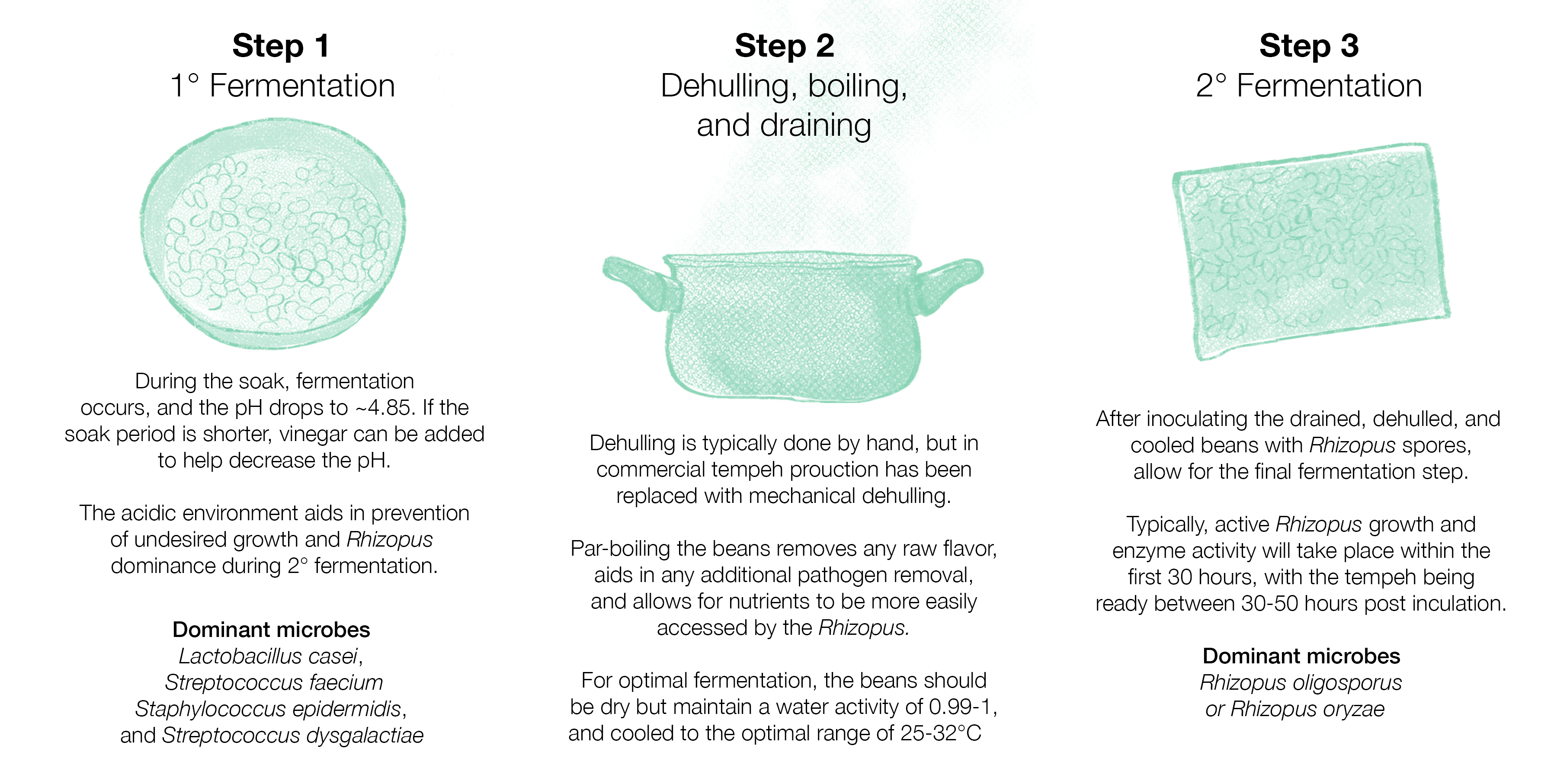Tempeh
Mold fermented soybean cakes
Ingredients:soybean
Taste: earthy, absorbs other flavors well
Popular in: Indonesia
Time: 2 days-3 months
Dominant microbes: Rhizopus oligosporus or Rhizopus oryzae
Tools: banana leaves or ziplock bag, incubator
tem‧peh
/ˈtɛmpeɪ/
/ˈtɛmpeɪ/
Recipe:
Basic Tempeh
Ingredients
soybeans
tempeh starter
Tools
Ziplock bags
- Soak 500g of soybeans for 12-24hours, massaging the beans regularly to dehull them. Remove any hull that has floated to the top.
- Drain the water and replace with fresh, massaging the beans to split and dehull them. Repeat until dehulling is complete. Boil the soybeans in fresh water without salt for about 1 hour.
- Drain the beans completely, and allow them to cool to body temperature.
- Add 1 teaspoon of tempeh starter, mixing well, and then place the inoculated beans in ziplock bags, filling each bag about halfway. Spread out the beans evenly, then seal each bag, poking small holes every few inches on both sides of the bag to allow for airflow.
- Incubate tempeh bags at 80°-89°F for 36-48hrs. After about 12 hours, you should begin to notice some fungal growth. Tempeh is completed when the mycelium has penetrated the mass.
- Store in the fridge and eat within 5 days.
what is tempeh starter?
Commercial tempeh starter found in the US is usually Rhizopus Oryzae or Rhizopus Oligosporus spores, sometimes mixed with a little rice flour to increase bulk and make it easier to measure out.
can I make my own tempeh starter?
Since tempeh starter is simply Rhizopus Oryzae or Rhizopus Oligosporus spores, you can allow your tempeh to sporulate, and then collect the excess fuzzy growth (spores), dry them, and use them in the next batch. However, given the chance of contamination, and the nature of tempeh fermentation, it’s safer to purchase until you have the correct set up and can recognize good sporulation.
Commercial tempeh starter found in the US is usually Rhizopus Oryzae or Rhizopus Oligosporus spores, sometimes mixed with a little rice flour to increase bulk and make it easier to measure out.
can I make my own tempeh starter?
Since tempeh starter is simply Rhizopus Oryzae or Rhizopus Oligosporus spores, you can allow your tempeh to sporulate, and then collect the excess fuzzy growth (spores), dry them, and use them in the next batch. However, given the chance of contamination, and the nature of tempeh fermentation, it’s safer to purchase until you have the correct set up and can recognize good sporulation.
tempeh microbiology
Rhizopus oligosporus
The most common tempeh mold starter, it is a domesticated strain of Rhizopus microsporus.
R. microsporus contains a bacterial endosymbiont (a bacteria that has a symbiotic relationship with the mold) called Paraburkholderia rhizoxinica, which plays a role in toxin production.
R. oligosporus’s strong lipolytic and proteolytic activity makes it a good candidate for the production of soy-free tempeh, using black beans or mung beans among other beans.
Rhizopus oryzae
Another common tempeh mold starter, typically used to ferment soy-based tempeh.
It produces a number of enzymes, including cellulases, hemicellulasesamylase, lipase, protease, urease, ribonuclease, pectate lyase, and polygalacturonase , making it a powerful industrial tool in the production of enzymes for various food applications.
R. oryzae has also been used in makgeolli production, and its resitance to high concentrations of lactic acid has made it a good option for commerical lactic acid production (Ghosh, 2011).
Other starters
There are various other Rhizopus molds that have been studies for tempeh production, including Rhizopus stolonifer, Rhizopus microsporus var. chinensis. While both have been looked at in the context of quantifying the bioavailability of nutrients following fermentation, both are not as optimal as R. oligosporus or R. oryzae.
R. stolonifer, also known as black bread mold, is considered food safe, but is also an opportunistic pathogen, so would not be safe for people who are immunocompromised.
Rhizopus microsporus var. chinensis, although closely related to Rhizopus microsporus does not exhibit the same endosymbiont relationship, and does not produce toxin. It has the ability to hydrolyzed sucrose and raffinose, and is used in the production of Chinese rice wine and Chinese liquor.
What is the source of the tempeh rhizopus mold?
Traditional tempeh production involved wrapping soybeans in banana, teak, or waru leaves, it is believed they are the source of initial Rhizopus mold. One study looking directly at this question found Rhizopus mold spores on Hibiscus leaves (waru in Indonesian)
Traditional tempeh production involved wrapping soybeans in banana, teak, or waru leaves, it is believed they are the source of initial Rhizopus mold. One study looking directly at this question found Rhizopus mold spores on Hibiscus leaves (waru in Indonesian)
lipolytic
From the Greek, lipo- meaning “fat” and -lytic meaning “able to loose” or “decomposiyion”. Lipolytic is the adjective describing the ability to break down fats. Enzymes resposible are called lipases or lipolytic enzymes
protelytic
From the Greek, lipo- meaning “fat” and -lytic meaning “able to loose” or “decomposiyion”. Lipolytic is the adjective describing the ability to break down fats. Enzymes resposible are called lipases or lipolytic enzymes
protelytic
From the Greek, proto- referring to proteins. Proteolytic is the adjective describing the ability to break down proteins. Enzymes resposible are called proteases
or proteolytic enzymes
or proteolytic enzymes

Ahnan-Winarno, Amadeus Driando, et al. "Tempeh: A semicentennial review on its health benefits, fermentation, safety, processing, sustainability, and affordability." Comprehensive Reviews in Food Science and Food Safety 20.2 (2021): 1717-1767.